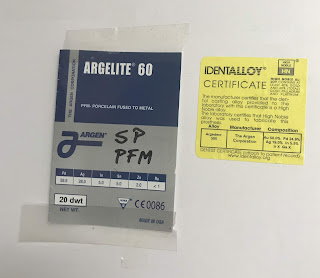What size retraction chord do you use?
The average lay reader doesn't know what retraction chord is and why it is used by dentists taking an elastomeric impression.Even most of my third year dental students do not fully understand how to use chord in order to facilitate taking impressions, so this post should be of special interest to them.
Dentist's use chord ( usually dipped in a hemostatic agent) and place it carefully between the gingiva and the prepared tooth. When it is removed there is a small space between the prepared tooth margin and the surrounding gingiva, hence the name "retraction chord".
Actually if a preparation ends entirely supragingivally, no retraction chord is really needed, but most preparations end at least in part subgingivally or at the gingival margin.
Before I place my chord I use viscostat (a ferric sulfate gel) applied with the syringe with an ultradent metal-dento infuser tip in place. This is gently rubbed into the sulcus with special attention given to spots that are still bleeding. Once I have achieved hemostasis I cover the prep with a wet two by two and wait 4 minutes.
Before I place my chord I use viscostat (a ferric sulfate gel) applied with the syringe with an ultradent metal-dento infuser tip in place. This is gently rubbed into the sulcus with special attention given to spots that are still bleeding. Once I have achieved hemostasis I cover the prep with a wet two by two and wait 4 minutes.
After removing the two by two, I gently wash the preparation and remove any of the brown coagulum that is present. If bleeding starts again I will reapply the viscostat using the above mentioned infuser tip. Once I have achieved hemostasis, it is time to pack my chord. The chord I use is made by Ultradent. It is a knitted chord so it holds together when it is packed. I use the unimpregnated type and dip it in the Viscostat hemostatic agent. Some dentists use hemodent instead of viscostat, but I believe viscostat is more biocompatable and possibly more gentle. For subgingival preps I use a double chord technique. First I gently place a 0 sized chord (purple) once around the preparation and then gently follow that with a size 1 chord (blue). The second chord shouldn't be completely buried in the sulcus and should partially visible between the retracted gingiva and the preparation. Two chords are placed of different thicknesses intentionally so that the sulcus will be narrower at the base and wider more coronally. When removed the entire sulcus should be visibly retracted and no tissue tags should rest on the preparation. I gently wash and dry the preparation and see if there is any bleeding. If there is I reapply viscostat using the proper ultradent syringe.
If I can't achieve a dry retracted field the first time I remove the chords, I will place the purple back in place and wait an additonal 4 minutes before removing it and taking an impression. Usually one or two chord placements is all that I need to get a good quality impression. I have copied a link to a video demonstrating the use of ultradent's products here. The dentist's technique is not the same but is similar to mine,
I often employ a single chord technique for preparation for emax or Zirconium crowns, since I often do not place their finish lines more than .5 mm subgingival. If I can place one layer of 0 sized chord and see my entire margin with the chord in place, I leave the chord in for my impression. Sometimes it comes out in the impression but that is not a problem since I can gently remove it using my college pliers usually without damaging my impression.
I often employ a single chord technique for preparation for emax or Zirconium crowns, since I often do not place their finish lines more than .5 mm subgingival. If I can place one layer of 0 sized chord and see my entire margin with the chord in place, I leave the chord in for my impression. Sometimes it comes out in the impression but that is not a problem since I can gently remove it using my college pliers usually without damaging my impression.
from Ask Dr. Spindel - http://lspindelnycdds.blogspot.com/2019/07/what-size-retraction-chord-do-you-use.html - http://lspindelnycdds.blogspot.com/


Comments
Post a Comment